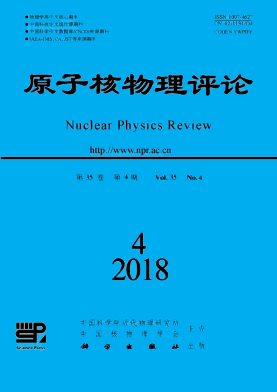|
[1]
|
MYERS W D, SWIATECKI W J. Nucl Phys A, 1966, 81:1. |
|
[2]
|
SOBICZEWSKI A, GAREEV F A, KALINKIN B N. Phys Lett, 1966, 22:500. |
|
[3]
|
ĆWIOK S, DOBACZEWSKI J, HEENEN P H. et al. Nucl Phys A, 1996, 611:211. |
|
[4]
|
HOFMANN S. Radiochim Acta, 2011, 99:405. |
|
[5]
|
MORITA K, MORIMOTO K, KAJI D. et al. J Phys Soc Jpn, 2007, 76045001. |
|
[6]
|
OGANESSIAN Y T. J Phys G:Nucl Part Phys, 2007, 34:R165. |
|
[7]
|
OGANESSIAN Y T. Radiochim Acta, 2011, 99:429. |
|
[8]
|
DVORAK J, BRUCHLE W, CHELNOKOV M. et al. Phys Rev Lett, 2006, 97:242501. |
|
[9]
|
BARAN A, POMORSKI K, LUKASIAK A, et al. Nucl Phys A, 2016, 361:83. |
|
[10]
|
HOFMANN S. J Phys G:Nucl Part Phys, 2015, 42:114001. |
|
[11]
|
ANGHEL C I, SILISTEANU I. Phy Rev C, 2017, 95:034611. |
|
[12]
|
BAO X J, GAO Y, LI J Q, et al. Phys Rev C, 2015, 92:034612. |
|
[13]
|
BAO X J, GAO Y, LI J Q, el al. Phys Rev C, 2016, 93:044615. |
|
[14]
|
XU C, REN Z Z. Phy Rev C, 2006, 74:014304. |
|
[15]
|
POENARU D N, PLONSKI I H, GREINER W. Phy Rev C, 2006, 74:014312. |
|
[16]
|
PEI J C, XU F R, LIN Z J, et al. Phys Rev C, 2007, 76:044326. |
|
[17]
|
ISMAIL M, ELLITHI A Y, BOTROS M M. et al. Phys Rev C, 2010, 81:024602. |
|
[18]
|
WANG Y Z, WANG S J, HOU Z Y, et al. Phys Rev C, 2015,92:064301. |
|
[19]
|
GHODSI O N, DAEI-ATAOLLAH A. Phys Rev C, 2016, 93:024612. |
|
[20]
|
FISET E O, NIX J R. Nucl Phys A, 1972, 193:647. |
|
[21]
|
SMOLAŃCZUK R, SKALSKI J, SOBICZEWSKI A. Phys Rev C, 1995, 52:1871. |
|
[22]
|
SMOLAŃCZUK R. Phys Rev C, 1997, 56:812. |
|
[23]
|
SWIATECKI W. Phys Rev, 1955, 100:937. |
|
[24]
|
XU C, REN Z Z. Phys Rev C, 2005, 71:014309. |
|
[25]
|
XU C, REN Z Z, GUO Y Q. Phys Rev C, 2008, 78:044329. |
|
[26]
|
KARPOV A V, ZAGREVAEV V I, MARTINEZ PALENZUELA Y, et al. Int J Mod Phys E, 2012, 21:1250013. |
|
[27]
|
WARDA M, EGIDO J L. Phys Rev C, 2012, 86:014322. |
|
[28]
|
STASZCZAK A, BARAN A, NAZAREWICZ W. Phys Rev C, 2013, 87:024320. |
|
[29]
|
CHOWDHURY P R, SAMANTA C, BASU D N. Phys Rev C, 2008, 77:044603. |
|
[30]
|
POENARU D N, GHERGHESCU R A, GREINER W. J Phys G:Nucl Part Phys, 2013, 40:105105. |
|
[31]
|
QIAN Y B, REN Z Z. Eur Phys J A, 2013, 49:5. |
|
[32]
|
SANTHOSH K P, SABINA S, JAYESH G J. Nucl Phys A, 2011, 850:34. |
|
[33]
|
SANTHOSH K P, PRIYANKA B, UNNIKRISHNAN M S. Phys Rev C, 2012, 85:034604. |
|
[34]
|
SANTHOSH K P, PRIYANKA B. J Phys G:Nucl Part Phys, 2012, 39:085106. |
|
[35]
|
QIAN Y B, REN Z Z. Phys Rev C, 2014, 90:064308. |
|
[36]
|
HILL D L, WHEELER J A. Phys Rev, 1953, 89:1102. |
|
[37]
|
ROYER G, REMAUD B. J Phys G, 1984, 10:1541. |
|
[38]
|
ROYER G, HADDAD F. Phys Rev C, 1995, 51:2813. |
|
[39]
|
ROYER G, ZBIRI K. Nucl Phys A, 2002, 697:630. |
|
[40]
|
BONILLA C, ROYER G. Acta Phys Hung A, 2006, 25(1):11. |
|
[41]
|
ZHANG H F, ROYER G, LI J Q. Phys Rev C, 2011, 84:027303. |
|
[42]
|
ZHANG H F, DONG J M, ROYER G, et al. Phys Rew C, 2009. 80:037307. |
|
[43]
|
DONG J M, ZUO W, GU J Z, et al. Phys Rev C, 2010, 81:064309. |
|
[44]
|
ROYER G. J Phys G:Nucl Part Phys, 2000, 26:1149. |
|
[45]
|
BAO X J, ZHANG H F, ZHANG H F, et al. Nucl Phys A, 2014, 921:85. |
|
[46]
|
BAO X J, GUO S Q, LI J Q, et al. Phys Rev C, 2017, 95:034323. |
|
[47]
|
WANG M, WAPSTRA A H, KONDEV F G, et al. Chin Phys C, 2012, 36:1287-1602. |
|
[48]
|
BAO X J, GUO S Q, ZHANG H F, et al. J Phys G:Nucl Part Phys, 2015, 42:085101. |
|
[49]
|
RANDRUP J, TSANG C F, MOLLER P, et al. Nucl Phys A, 1973, 217:221. |
|
[50]
|
DONG J M, ZUO W, SCHEID W. Phys Rev Lett, 2011, 107:012501. |
|
[51]
|
PEREZMARTIN S, ROBLEDO L M. Int J Mod Phys E, 2009, 18:788-797. |
|
[52]
|
MPLLER P, SIERK A J, ICHIKAWA T, et al. Phys Rev C, 2015, 91:024310. |
|
[53]
|
JACHIMOWICZ P, KOWAL M, SKALSKI J. Phys Rev C, 2017, 95:014303. |
|
[54]
|
WANG N, LIU M, WU X, et al. Phys Lett B, 2014, 734:215. |
|
[55]
|
QI C, XU F R, LIOTTA R J, et al. Phys Rev Lett, 2009, 103:072501. |
|
[56]
|
NI D D, REN Z Z, DONG T K, et al. Phys Rev C, 2008, 78:044310. |
|
[57]
|
ZHAO T L, BAO X J, GUO S Q. J Phys G:Nucl Part Phys, 2018, 45:025106. |






 甘公网安备 62010202000723号
甘公网安备 62010202000723号 DownLoad:
DownLoad: